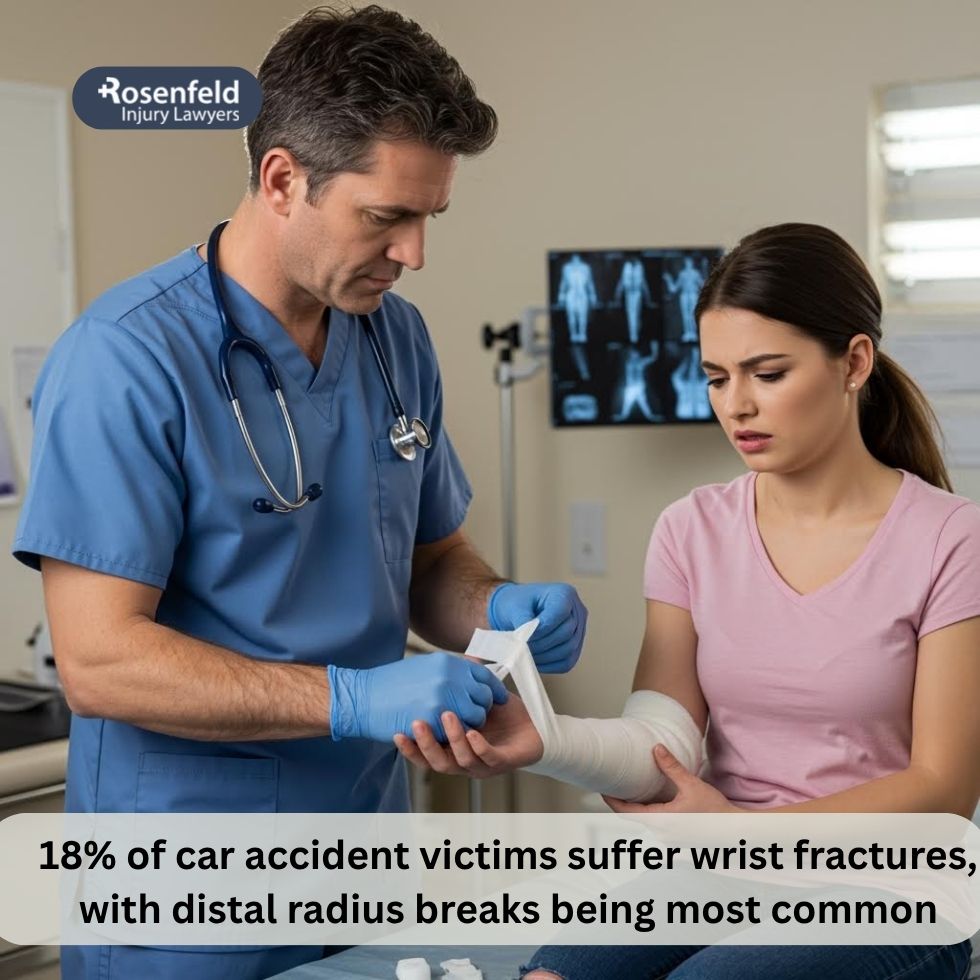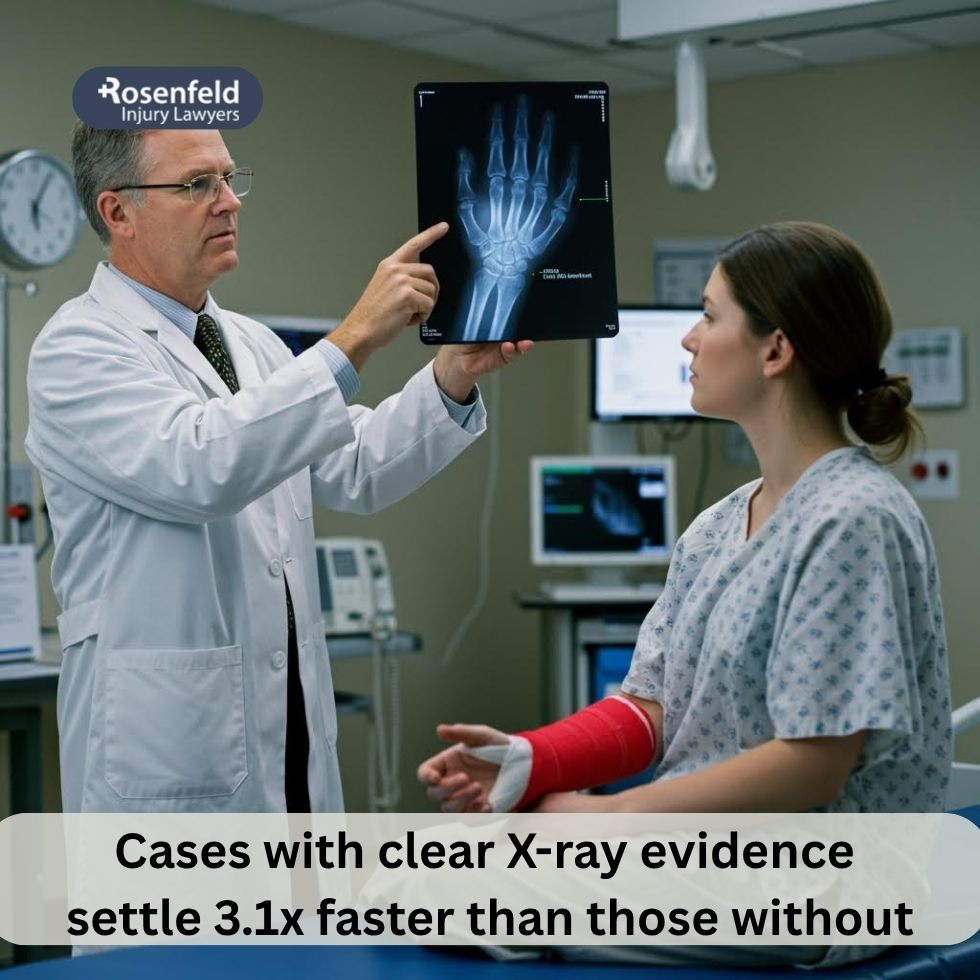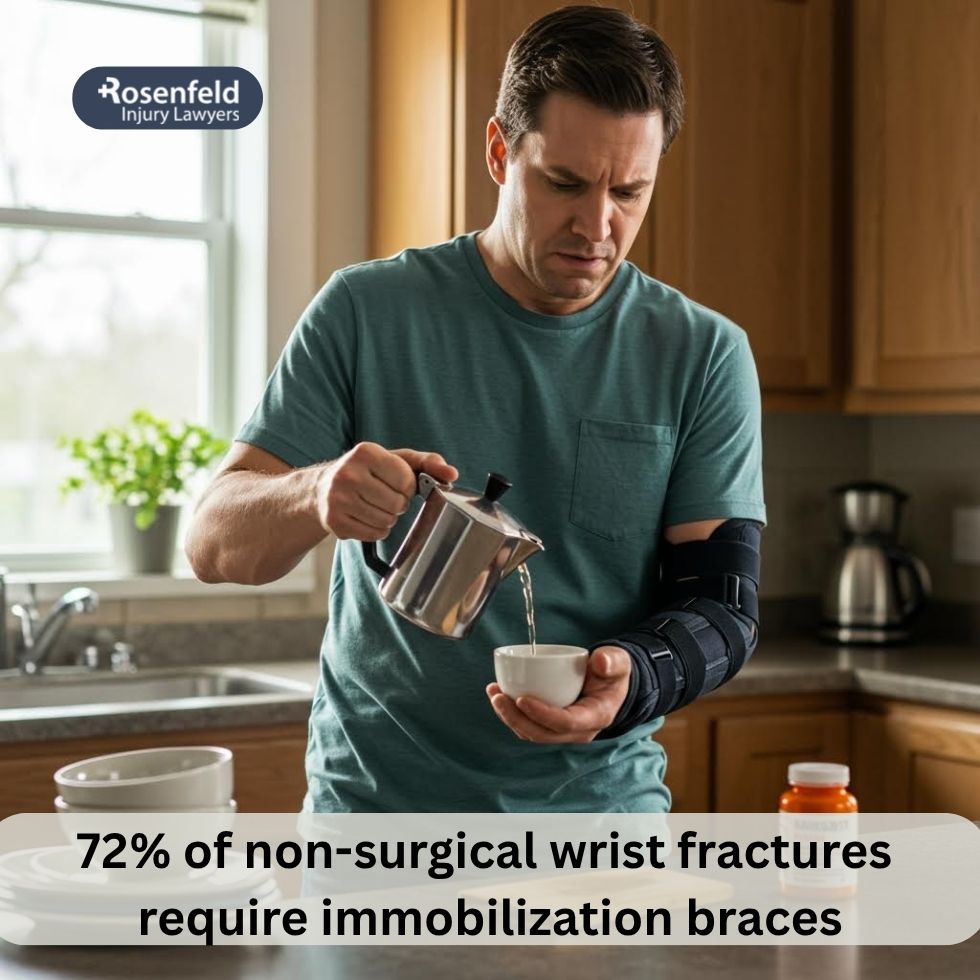- 24/7 Free Consultation: (888) 424-5757 Tap Here To Call Us
What Are the Signs of a Wrist Fracture After a Car Accident?
Car accident injuries come in many forms, but wrist fractures are among the most common and disruptive. A wrist fracture may not seem as life-altering as a head or spine injury, but it can still impact your ability to work, drive, and perform daily tasks. So, what are the signs of a wrist fracture after a car accident?
If you’re experiencing pain or swelling in your wrist after a collision, you may have suffered a broken bone and need prompt medical evaluation. Understanding the signs of a wrist fracture after a car accident and how to pursue compensation is crucial. A Chicago car accident lawyer can help you protect your rights and seek financial recovery.
How a Wrist Fracture Can Happen in a Car Accident
A broken wrist often results from blunt force or awkward movements during a crash. Some of the most common causes of wrist fractures include bracing for impact against the steering wheel, being struck by an inflating airbag, or trying to stop a fall with an open hand.
Known as FOOSH (Fall On an Outstretched Hand), this instinctive action can cause serious wrist injuries under high-impact conditions. Wrist fractures occur when pressure is transferred through the hand into the small bones of the wrist, typically resulting in damage to the radius bone or surrounding carpal bones.

Common Symptoms of a Bone Fracture in the Wrist
After a crash, recognizing early signs of a broken wrist can be difficult, especially when adrenaline is high. Watch for symptoms like swelling, bruising, limited motion, or visible deformity. Many wrist fractures cause a dull or deep pain that worsens when you move your fingers or attempt to grip objects.
Numbness or tingling in the hand may indicate blood vessel damage or nerve compression. If a bone fragment pierces through the skin, this is classified as an open fracture, requiring immediate medical attention.
Distal Radius Fracture: One of the Most Common Wrist Injuries
The distal radius, the largest bone in the forearm near the wrist, plays a critical role in wrist movement and support. It’s one of the two forearm bones, and when it breaks near the wrist joint, usually due to sudden force in a car accident, the result is a distal radius fracture.
This type of wrist fracture typically occurs when someone tries to protect themselves by bracing against the steering wheel or instinctively extending their arm during impact.
Depending on how the break occurred, some wrist fractures are relatively stable, while others are more severe and require advanced care. The seriousness of a broken wrist depends on how well the bones stay aligned, how much of the joint is affected, and whether the surrounding tissue is also damaged.
For any suspected break, a timely X-ray is crucial for a proper diagnosis.
Intra-Articular Distal Radius Fracture
This type of wrist fracture reaches into the wrist joint, where movement occurs. Because it affects the largest bone in the forearm near the joint’s smooth surfaces, patients often experience severe pain, swelling, and stiffness. Restoring mobility may involve precise treatment to stabilize the joint and prevent long-term problems like arthritis.
Extra-Articular Distal Radius Fracture
Extra-articular wrist fractures stay outside the joint but can still lead to complications if the bone fragment shifts out of position. In many cases, bruising and difficulty rotating or gripping objects are early signs of trouble. Even without joint involvement, a misaligned radius bone may impact function if not treated properly.
Don’t Confuse a Wrist Sprain with a Wrist Fracture
A wrist sprain affects the ligaments, while a break impacts the bone, most commonly the distal radius bone. Since both can cause swelling and pain, it’s easy to overlook a wrist fracture. However, symptoms like deformity, persistent discomfort, or restricted motion should prompt a visit to a doctor to assess for more serious fractures to the injured wrist.

Other Types of Broken Wrists in Car Accidents
Car crashes can cause several types of fractures, depending on how the wrist absorbs the impact. Here are the different types of wrist fractures common in car accidents:
Colles Fracture
A Colles fracture affects the end of the radius and usually results from falling onto an outstretched hand. The wrist bends upward at an unnatural angle, sometimes creating a visible deformity. This type of fracture is especially common in rear-end collisions.
Comminuted Fracture
In a comminuted fracture, the bone shatters into three or more pieces. This is more serious and frequently needs surgery, including metal plates or screws to stabilize the fragments and restore proper alignment.
Open Fracture
Also known as a compound fracture, this occurs when the broken bone penetrates the skin. Compound fractures carry a high risk of infection and typically require urgent surgical care.
Smith Fracture
A Smith fracture occurs when the lower forearm breaks and shifts forward instead of backward. Though less common than a Colles wrist fracture, it can be more difficult to treat and may lead to long-term instability.
The Link Between Car Accidents and Wrist Fractures
The wrist is particularly vulnerable in a car crash due to its role in bracing or gripping during sudden movement. Drivers who tightly grip the steering wheel often absorb significant force through the wrist bones, increasing the risk of wrist fracture.
When an airbag deploys, it can strike the wrist at high velocity. Passengers may also injure their wrists by pushing against the dashboard or nearby surfaces as they brace for impact. These are all scenarios where wrist fractures occur, especially involving the lower radius bone or smaller bones like the scaphoid bone.
Why Immediate Medical Attention is Crucial After a Car Accident
Wrist fractures can go unnoticed if symptoms are subtle or if the victim is focused on other injuries. However, seeking prompt medical attention is vital to prevent complications. X-rays and CT scans can reveal even minor fractures that could worsen without stabilization.
If a fracture isn’t treated early, it may not heal properly, increasing the risk of chronic pain, stiffness, or reduced range of motion.
Scaphoid Fractures and the Risk of Misdiagnosis
The scaphoid bone sits near the base of the thumb and is prone to injury during car crashes. A scaphoid fracture can be difficult to detect on initial X-rays, especially if the break is small or incomplete. These wrist fractures often present with dull or deep pain, limited grip strength, and tenderness near the thumb.
Without proper diagnosis and treatment, a fractured scaphoid may lead to long-term complications, including reduced wrist mobility or avascular necrosis. In this condition, bone tissue dies due to poor blood supply.

Treatment Options for a Broken Wrist
Treatment depends on the severity of the break. A stable wrist fracture may heal with a cast or splint, but a comminuted or unstable fracture often requires surgical intervention. In cases of severe pain, seeking prompt medical attention is critical to avoid complications.
Severe fractures may call for an external fixator or internal plates to keep the wrist in the correct position as it heals.
Some patients need physical therapy to rebuild strength and flexibility, especially when the fracture happens near a joint or involves surrounding soft tissue injuries. An early and accurate diagnosis helps prevent long-term issues such as bone misalignment or permanent stiffness.
How Long Does It Take for a Bone Fracture in the Wrist to Heal?
Healing timelines vary based on wrist fracture type:
- Minor fractures typically take six to eight weeks.
- A wrist fracture that requires surgical intervention may need three to six months, including rehab.
- If wrist bones are misaligned or soft tissues are damaged, healing may take longer and require follow-up procedures.
The outcome depends on how well the bones heal and whether complications like arthritis or nerve damage develop. Some cases result in lasting discomfort, particularly if the wrist joint is involved.
Car Accident Compensation for Broken Wrists
Wrist fractures come with physical, financial, and emotional burdens. Medical bills from surgery, imaging, and physical therapy can add up quickly. Many people with a broken wrist are forced to take time off work or switch to limited-duty roles. Compensation through a personal injury claim may cover the following:
- Immediate medical costs and future treatment
- Lost income during recovery
- Pain and suffering caused by chronic symptoms or mobility issues
- Long-term care or wrist surgeries if the joint doesn’t heal properly
The average settlement for wrist or finger injuries in car accidents is approximately $115,000, depending on the severity of the fracture and how it affects the injured person’s ability to work and function. A car accident attorney can help maximize your settlement.
Get Legal Help for a Wrist Fracture After a Car Accident

If you suffered a wrist fracture after a car accident, don’t wait to explore your legal options. A skilled lawyer can investigate the incident, identify if a negligent driver was involved, and determine the full extent of damages. An experienced car accident attorney will handle the details so you can focus on healing.
Our Chicago-based legal team is committed to helping victims pursue financial compensation for broken wrists caused by steering wheel impact, airbag deployment, or bracing with an extended arm. Contact us today for a free consultation and get the support you need to move forward.
Call (888) 424-5757 or fill out our online form.
All content undergoes thorough legal review by experienced attorneys, including Jonathan Rosenfeld. With 25 years of experience in personal injury law and over 100 years of combined legal expertise within our team, we ensure that every article is legally accurate, compliant, and reflects current legal standards.







